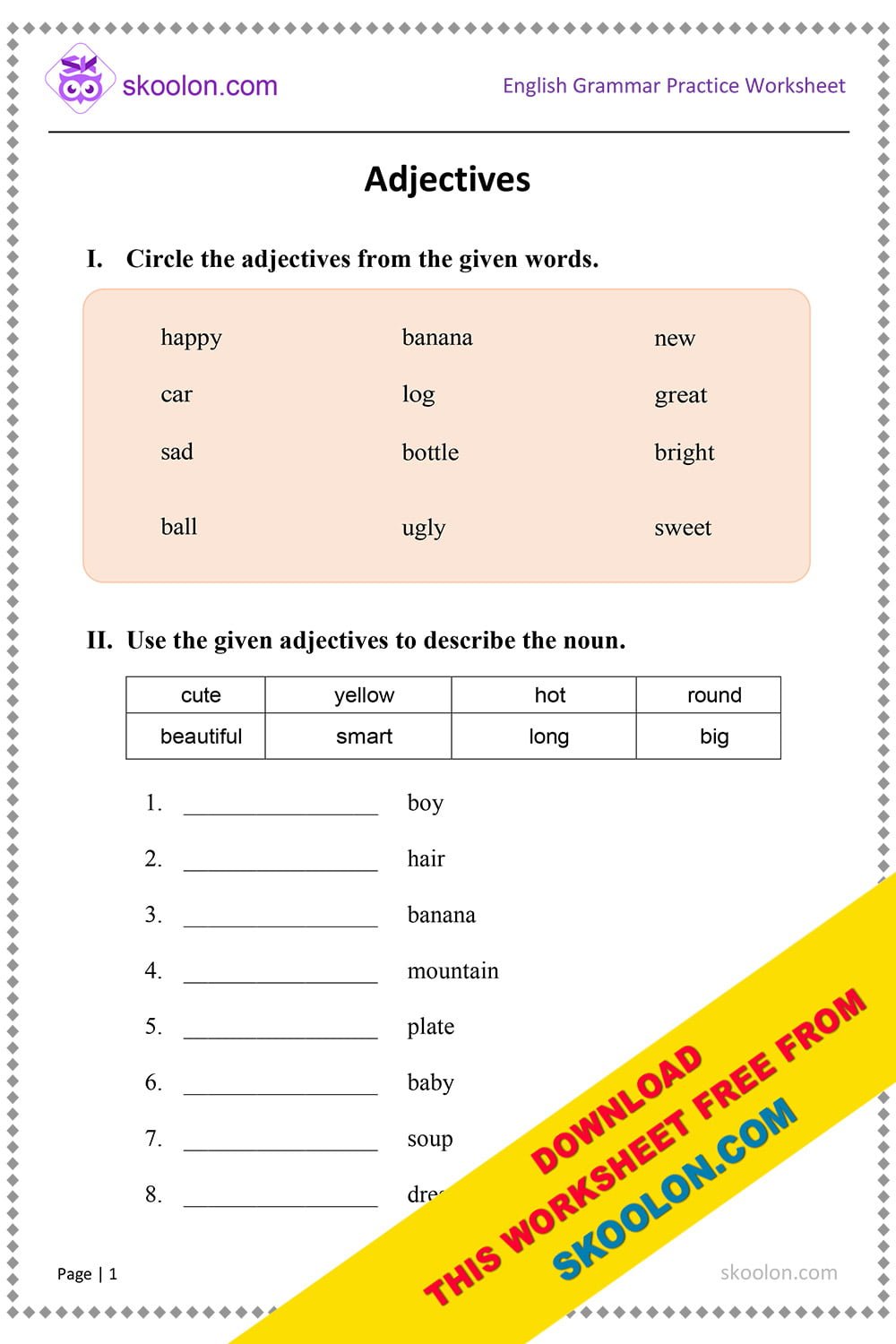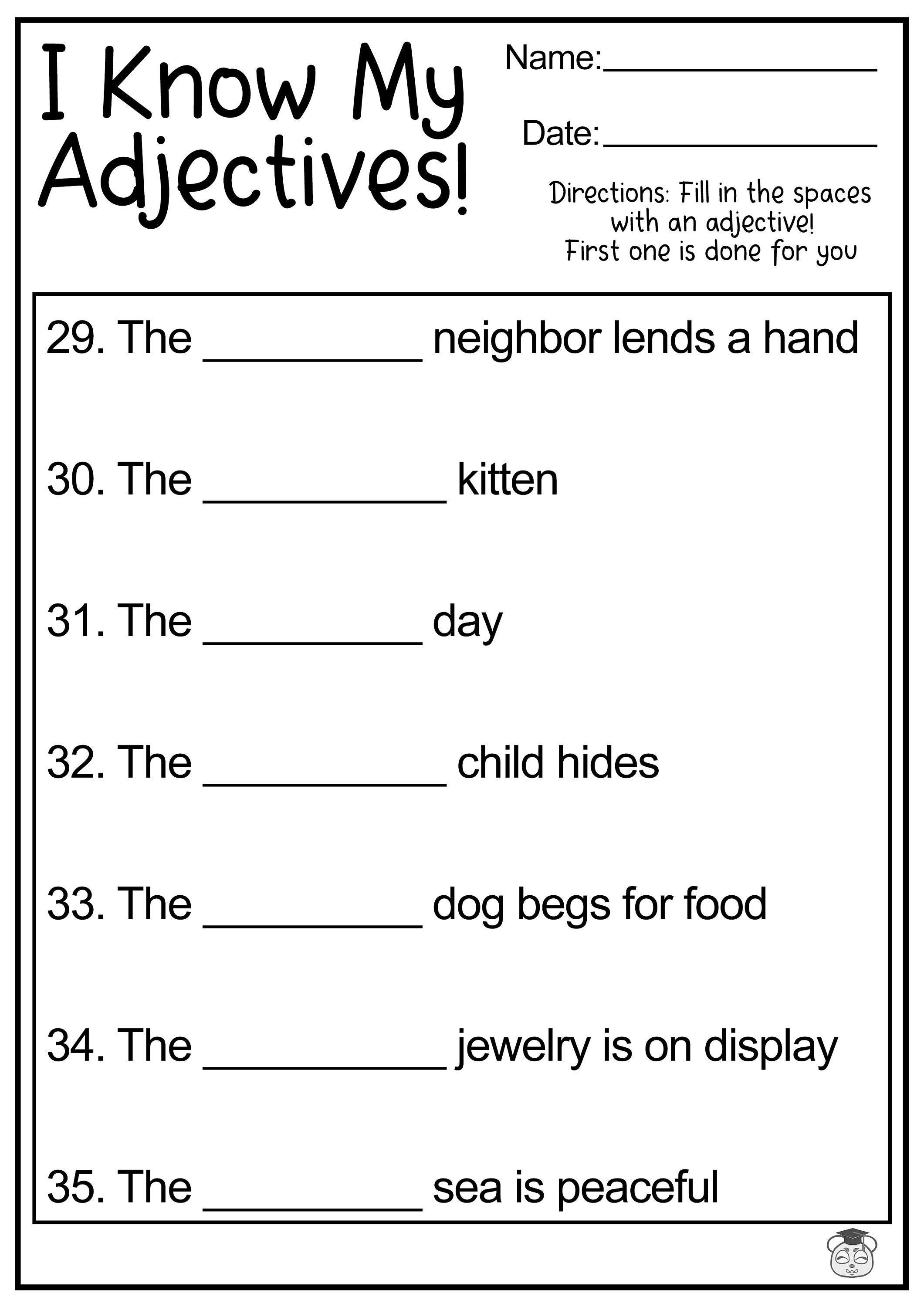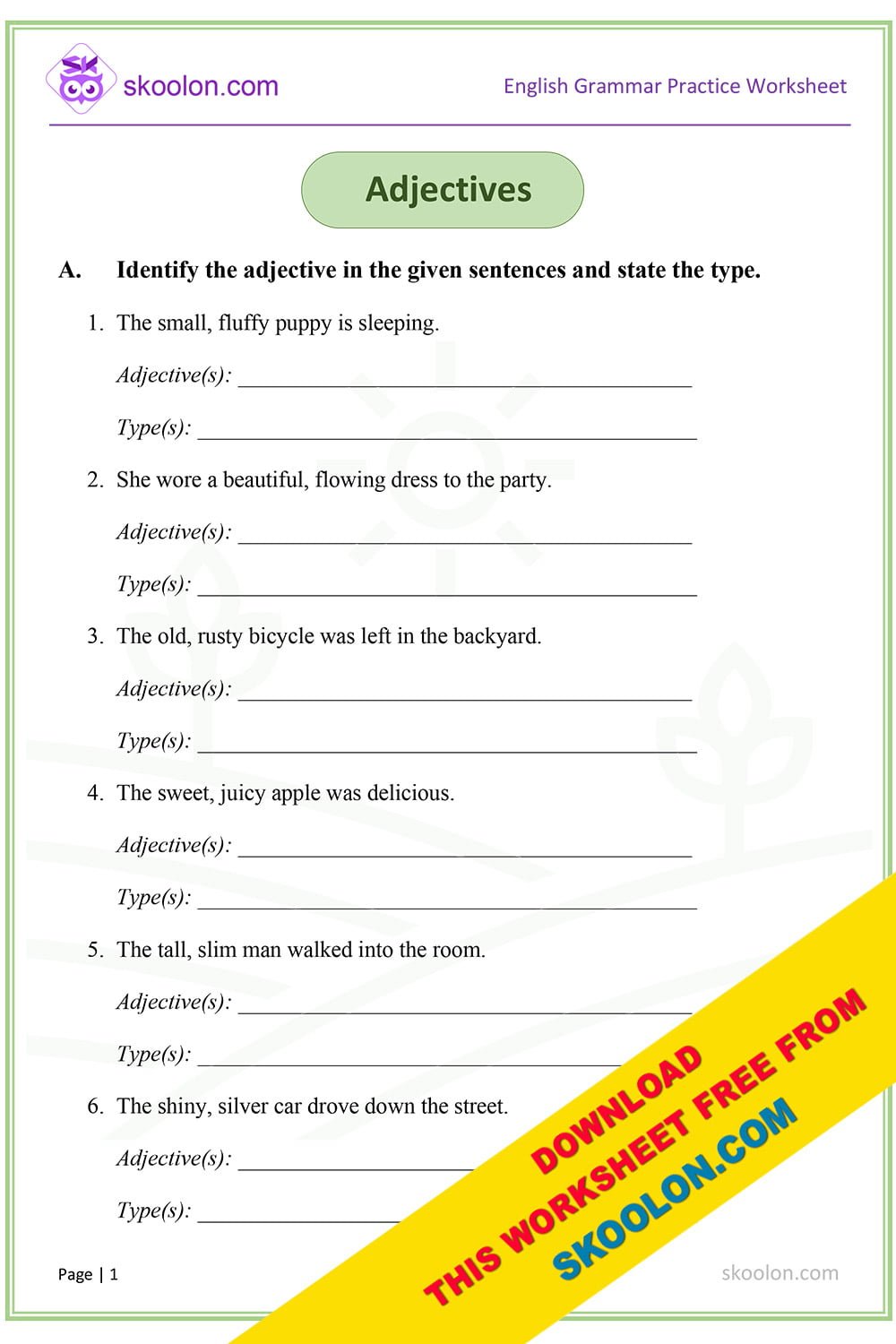
Mastering Descriptive Language: The Power of Grammar Worksheets: Adjectives
In the vast landscape of language learning, mastering grammar is akin to laying a strong foundation for a sturdy building. Without a solid grammatical structure, even the most eloquent vocabulary can crumble, leading to miscommunication and a lack of clarity. Among the many components of English grammar, adjectives stand out as indispensable tools for vivid expression. They paint pictures with words, add depth to descriptions, and allow speakers and writers to convey nuanced meanings. To effectively grasp and apply these descriptive powerhouses, targeted practice is essential, and this is precisely where Grammar Worksheets: Adjectives prove invaluable.
Adjectives are words that describe or modify nouns and pronouns. They answer questions like "which one?", "what kind?", or "how many?". Simple examples include "red car," "tall tree," "happy child," or "five fingers." While seemingly straightforward, the correct and effective use of adjectives involves understanding their types, forms (comparative and superlative), order in a sentence, and their distinction from adverbs. For language learners, both native and non-native, this can present a significant challenge. This is where the structured, repetitive, and focused nature of Grammar Worksheets: Adjectives becomes a cornerstone of effective learning.
The Indispensable Role of Adjectives in Communication

Before delving into the specifics of worksheets, it’s crucial to appreciate the fundamental role adjectives play in language. Imagine describing a scene without them: "The house stood on a street. A dog barked." Now, add adjectives: "The old, dilapidated house stood on a quiet, tree-lined street. A tiny, yappy dog barked loudly." The difference is profound. Adjectives transform bland sentences into rich, evocative prose. They allow us to:

- Add Detail and Specificity: Instead of just "a book," we can say "an ancient, leather-bound book."
- Convey Emotion and Tone: "A sad song" or "a joyful celebration" immediately sets a mood.
- Differentiate and Distinguish: "The bigger apple" clarifies which one is being discussed.
- Enhance Persuasion: In advertising or debate, strong adjectives can sway opinions.
- Improve Comprehension: By providing clearer descriptions, adjectives reduce ambiguity.



Without a strong command of adjectives, one’s communication remains generic and uninspired. This underscores the need for dedicated practice, which Grammar Worksheets: Adjectives are perfectly designed to provide.

Why Worksheets Are Effective Learning Tools
Worksheets, in general, have long been a staple in educational settings, and for good reason. They offer a structured environment for practice and reinforcement. Their benefits include:

- Targeted Practice: Worksheets allow learners to focus on a specific grammatical concept in isolation.
- Repetition for Retention: Repeated exposure to a concept through various exercises helps solidify understanding and memory.
- Self-Paced Learning: Learners can work through worksheets at their own speed, reviewing difficult sections as needed.
- Immediate Feedback: With answer keys, learners can check their work instantly, identifying errors and correcting them.
- Assessment Tool: Teachers can use worksheets to gauge student understanding and identify areas needing further instruction.


When applied to the nuanced world of adjectives, these general benefits become even more pronounced, making Grammar Worksheets: Adjectives an exceptionally potent learning resource.
The Unique Benefits of Grammar Worksheets: Adjectives
The focused nature of Grammar Worksheets: Adjectives allows learners to isolate and concentrate on this specific part of speech, addressing its various facets systematically. Here are some key benefits:
- Identification and Recognition: Many worksheets begin with exercises that require learners to simply identify adjectives in a given sentence or passage. This foundational skill is crucial for understanding their role and placement.
- Correct Usage and Placement: Adjectives typically precede the noun they modify (e.g., "beautiful flower"). Worksheets help reinforce this basic structure, preventing common errors like "flower beautiful."
- Mastering Comparative and Superlative Forms: This is a common stumbling block. Worksheets provide ample practice in transforming adjectives (e.g., "big," "bigger," "biggest"; "beautiful," "more beautiful," "most beautiful"). They also address irregular forms like "good," "better," "best."
- Understanding the Order of Adjectives: When multiple adjectives modify a single noun, there’s a conventional order (opinion, size, age, shape, color, origin, material, purpose). Worksheets with sentence rearrangement tasks are excellent for internalizing this complex rule (e.g., "a beautiful big old round red French wooden carving knife" – a mouthful, but with a specific order).
- Distinguishing Adjectives from Adverbs: Learners often confuse words that look similar but function differently (e.g., "quick" vs. "quickly"). Worksheets can present sentences where learners must choose between an adjective and an adverb, solidifying their understanding of what each modifies (noun/pronoun vs. verb/adjective/adverb).
- Vocabulary Expansion: By encountering a wide range of descriptive words in context, learners naturally expand their vocabulary. Worksheets can even be designed to introduce synonyms and antonyms for common adjectives.
- Building Confidence: Successfully completing exercises on Grammar Worksheets: Adjectives provides a sense of accomplishment, boosting a learner’s confidence in their grammatical abilities and encouraging them to take on more complex language tasks.
- Reinforcing Grammatical Rules: Through repeated application in varied contexts, the rules governing adjectives become ingrained, moving from conscious effort to automatic usage.
Types of Activities Found in Grammar Worksheets: Adjectives
Effective Grammar Worksheets: Adjectives incorporate a variety of exercise types to keep learners engaged and address different learning styles. Some common and highly effective activities include:
- Fill-in-the-Blanks: Sentences with missing adjectives, where learners choose from a word bank or generate their own.
- Matching Exercises: Matching adjectives to the nouns they might describe, or matching adjectives to their comparative/superlative forms.
- Sentence Rewriting/Expansion: Learners are given simple sentences and asked to add appropriate adjectives to make them more descriptive.
- Identifying Adjectives in Passages: Providing a short story or paragraph and asking learners to underline or circle all the adjectives.
- Choosing the Correct Form: Multiple-choice questions requiring learners to select the correct comparative or superlative form of an adjective.
- Error Correction: Sentences with incorrect adjective usage (e.g., wrong form, wrong order) that learners must identify and correct.
- Adjective Order Drills: Scrambled lists of adjectives and a noun, requiring learners to arrange the adjectives in the correct conventional order.
- Creative Writing Prompts: Asking learners to write short paragraphs or sentences using a specified number or type of adjectives to describe a person, place, or object.
- Adjective vs. Adverb Distinction: Exercises where learners must decide whether an adjective or an adverb is needed in a given sentence.
Designing and Utilizing Effective Grammar Worksheets: Adjectives
For educators, parents, or self-learners looking to create or select effective Grammar Worksheets: Adjectives, several principles should be considered:
- Clear Instructions: Ensure the instructions for each exercise are unambiguous and easy to understand.
- Varied Exercise Types: As mentioned above, a mix of activities prevents monotony and caters to different learning preferences.
- Gradual Difficulty: Start with simpler identification tasks and progressively move to more complex application, transformation, and error correction exercises.
- Contextualized Sentences: Using sentences that are relatable and meaningful to the learner makes the exercises more engaging and helps them see the practical application of adjectives. Avoid abstract or nonsensical sentences.
- Include Answer Keys: For self-study, an answer key is crucial for immediate feedback and self-correction. For classroom use, it aids in quicker grading and peer review.
- Engaging Content: If possible, tie the worksheet content to themes or topics that are interesting to the target audience (e.g., animals, sports, travel, food).
- Visuals: For younger learners or visual learners, incorporating simple illustrations can enhance engagement and comprehension.
Integrating Worksheets into a Comprehensive Learning Strategy
While incredibly beneficial, Grammar Worksheets: Adjectives should not be the sole component of language learning. They are most effective when integrated into a broader strategy that also includes:
- Reading: Exposing learners to how adjectives are used in authentic texts.
- Listening: Paying attention to adjectives in spoken language.
- Speaking: Encouraging learners to use adjectives naturally in conversations.
- Writing: Providing opportunities for learners to apply their knowledge of adjectives in their own creative and descriptive writing.
- Games and Interactive Activities: Making learning fun and collaborative.
Worksheets provide the structured practice that builds foundational understanding, which can then be applied and reinforced through more communicative and creative activities. They can be used for pre-assessment to gauge prior knowledge, for in-class practice, for homework assignments, or for supplementary review.
Conclusion
In conclusion, Grammar Worksheets: Adjectives are far more than just repetitive exercises; they are foundational tools that empower learners to master one of the most expressive parts of speech in the English language. By providing targeted practice in identification, correct usage, comparative and superlative forms, and the often-tricky order of adjectives, these worksheets systematically build the skills necessary for vivid and precise communication.
Embracing the potential of Grammar Worksheets: Adjectives means investing in a comprehensive approach to language education that values both the mechanics and the artistry of words. With consistent engagement, learners can transform their ability to describe the world around them, turning simple statements into rich tapestries of detail and emotion. Ultimately, a strong command of adjectives, honed through dedicated practice with well-designed worksheets, is a significant step towards achieving true fluency and eloquence in English.
